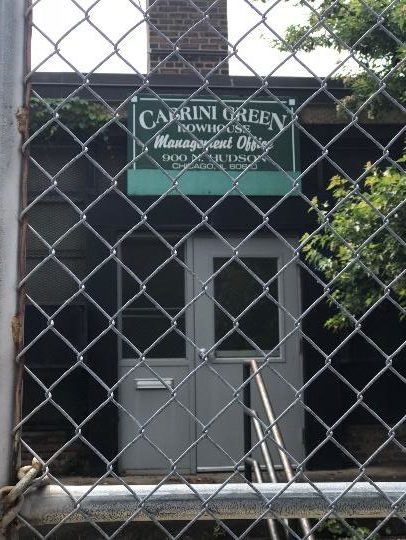By Daniel Walker
I recently took a tour through the old Cabrini Green area in Chicago. This once infamous low-income housing project has now vanished. Today, the area is completely gentrified with high-priced condos, beautiful parks and thriving restaurants and shops. Seeing the new community while also seeing pictures and hearing stories of what it used to be was surreal and impressive, yet disturbing all at once. The new neighborhood is wonderful, but where did the projects go, and more importantly, what happened to the people who lived there?
History and Redevelopment of Cabrini Green
Cabrini Green was located on 70 acres of land in the Near North Side area of Chicago. It included 3,605 units in 77 buildings and had capacity to house over 15,000 low-income residents. Construction began in the 1940’s with the Cabrini Rowhouses (584 units). The city added the mid- and high-rise Cabrini Homes in the 1950’s (1,925 units) and the high-rise Green Homes in the 1960’s (1,096 units). It was known for its gang violence, crime and drug activity, along with extremely poor living conditions. Its notoriety grew as Cabrini Green was regularly in the news and in movies like Cooley High (1975) and Candyman (1992), and in the 1970’s television show Good Times.
The Chicago Housing Authority (CHA) launched a strategy of replacing low-income housing with mixed-income housing in 1994. From 1995 to 2011, the CHA knocked down all of the mid- and high-rise buildings and invested millions of dollars to initiate the redevelopment of this area. The approach was formalized in 1997 with the Near North Redevelopment Plan. The three goals (page 17) were to:
- Create a healthy mixed-income neighborhood.
- Reduce or eliminate the blighting conditions.
- Employ residents of the Redevelopment Project Area.
Justice for Cabrini Green
So much good came from 24 years of redevelopment. The community is safe and healthy with a new library, school and police station, along with new housing and upgraded parks. The housing is now mixed-income. Many of the remaining residents are employed by new businesses, and the Near North Unity Program established in 2010 has given neighbors a structured way to give input into the neighborhood priorities and design standards.
Injustice for Cabrini Green
Despite these benefits, the redevelopment also caused injustice.
Residents Left Out:
The greatest fear of the residents was that they would be left out. They were right. After 24 years of redevelopment approximately 80% of the residents, 4 out of 5, were not allowed to remain or return to new or rehabbed units. Instead, most residents were forced to relocate to Section 8 housing or other low-income housing often in neighborhoods with high crime and violence.
| CHA Units | Apartments | Row houses | Total |
| Initial # in 1994 | 3,021 | 584 | 3,605 |
| # planned to be Demolished | 3,021 | 0 | 3,021 |
| # planned to be Built or Rehabbed | 700 | 584 | 1,284 |
| Actual # Completed | (Estimated) 700 | 0 | 700 |
| Percentage Actually Completed | 23.2% | 0% | 19.4% |
These numbers are in alignment with the CHA 2011 Report (page 3) that across all of Chicago, only 20 percent of low-income residents were in the new mixed-income housing.
No Ownership:
One of the key opportunities for gentrification with justice is creating ownership opportunities. According to the Near North Unity Program, in 2015, the median home value in the neighborhood is $426,000, far out of reach for most of the original residents. The CHA budgeted for assistance for relocation and job training, but there was no funding, no programs and no intent to assist with home ownership.

Row Houses Boarded and Fenced:
Picture this…think of 584 row houses, now think of 444 of them boarded up. Imagine a 10 foot chain link fence surrounding the property. There is only one way in and out. This is the Cabrini Rowhouses of today. From the outside, it looks like a prison or condemned property. The CHA never fulfilled its promise to rehab the row houses. Yet, approximately 140 units are still occupied in the middle of the row house complex.
Of everything that I saw in the Cabrini Green area, this was the most disgraceful and disheartening. It is negligent to leave 140 families living in such conditions.
The Welfare of the City
God calls us to love our neighbor and care for those in need, but is there particular guidance concerning city redevelopment? Two sections of scripture seem particularly applicable. The first is Jeremiah 29:5-7 where God, through the prophet Jeremiah, gives direction for the exiles in Babylon. God tells them to build houses, plant gardens, marry and have kids, and increase in number. Further, he instructs them to seek the welfare of the city and pray for it, for as it prospers, they too would prosper.
The second scripture is Numbers 27:3-11. In this text the daughters of Zelophehad come to Moses demanding that he give them property. Their father died without having a son, so according to inheritance law, they would not receive property. Moses presents their case before God, and God declares that they are right and tells Moses to give them their property.
What guidance comes from these texts concerning city restoration with righteousness? First, restoration is good. We are to build houses, plant gardens and grow together (Jer. 29:5-6). Second, the way we do this is extremely important. Community redevelopment must prioritize the welfare of the residents of the city (Jer. 29:7). Finally, we should pay special attention to the marginalized who are often neglected in our systems, particularly in wealth-generating areas like property ownership (Num. 27:7).
The Conclusion
Walk the streets of Cabrini Green today and you will see that the CHA accomplished its 1997 goals. They created mixed-income neighborhoods, removed blight and employed residents. Yet something is intolerably wrong. The original residents were left out through displacement, left out of home ownership, and left out by being left in the boarded and fenced Cabrini Rowhouses. Redevelopment, yes, but at the cost of leaving the residents behind. The CHA would do well to consider home ownership in future planning. They must also address the Cabrini Rowhouses and increase the number of CHA mixed-income units. Only then will this mixed-income strategy stop leaving out the low-income residents that it was originally created to serve.

Dan Walker is a community pastor, advocate and speaker living in Marion, IN. He is pursuing a Doctorate in Urban Ministry Leadership at North Park Theological Seminary in Chicago.




